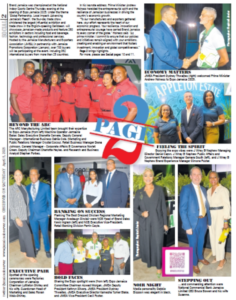
65-year review – Part One
LAST Saturday’s race meeting celebrated the 65th anniversary of local horse racing transitioning from the grass track in Knutsford Park/New Kingston to racing at one of the most modern and acclaimed sand surfaces this side of the Atlantic in 1959.
Influenced by the configuration of racetracks in the United Kingdom, the design included a 600-metre and a 400-metre chute, complementing a circuit of 1820 metres. Importantly, on-track betting was facilitated by the most modern electro-magnetic totalizator system of the time to produce tickets.
On the 200-hectare green area of the Caymanas sugar estate the facility’s accommodation for 1400 horses, and importantly the water resource of a well, were lauded as the most important development in any sport. Justifiably, this of course was prior to the 1962 opening of the multipurpose National Stadium. In terms of a response, the investment in ownership, breeding, and the importation of English bloodstock for racing was nothing short of phenomenal.
Firstly, the growth of the sport was guaranteed by the establishment of the Betting, Gaming & Lotteries Commission on January 1, 1966, followed by a Government Levy Scheme to lend support to the industry. From thereon, gaming on horse racing improved exponentially with the issuance of bookmakers’ licences to conduct wagering on local and English racing.
The local product enjoyed affirmative action in that the bookmakers had to cease operation an hour before post time of the first local race. However, unfortunately, this facilitated unlicensed operatives offering race-by-race betting, which kept the BG&LC inspectors busy each race day.
Secondly, the industry was moved to a more professional level by the Jamaica Racing Commission Act of February 4, 1972 for which the House Of Representatives and Senate took credit and which was signed by Governor General Sir Clifford Campbell.
Effectively, the commission took over the regulatory functions performed by the English model Jockey Club. Importantly, the earnings of the operatives in professional training, riding, and grooming were mandated to earn a formalised rate of 15 per cent, 10 per cent and 5 per cent of total purse, respectively.
To facilitate more efficient wagering, the third of the most important developments was undoubtedly when Minister of Finance Seymour Mullings led the negotiations with his colleagues in Government to fund the establishment of a digital platform in 1988, and the resurfacing of the racing surface. Importantly, the menu betting options of only four (win, place, doubles and quinellas) increased to more than 10 to include exotics.
By 1992, off-track betting points of sale were expanded to 67 from 27, and this created an extraordinary new dynamic — the bookmakers, with over 600 betting offices operational islandwide, commanded a 60 per cent share of this gaming market. However, within four years of the availability of the digital platform there was a complete reversal of the ratio. Promoting company Caymanas Track Limited (CTL) relegated the bookmakers to 40 per cent, however the 10 per cent annual growth rate of the number of races guaranteed their continuous viability.
Additionally, a decision to offer six-day-weekly simulcast betting on tracks in North America in 1988 was revolutionary. This enabled CTL to survive two potential disasters. On the 12th of September 1988 the impact of Hurricane Gilbert caused the suspension of racing until late December of that year.
Then in late December of 1989 there was an outbreak of equine influenza, with resumption only possible early in March 1990. This may surprise those who would be unaware but being funded by the conduct of simulcast betting over this December to March period enabled CTL to offer a stipend to the most affected operatives.
Interestingly, current promoting company Supreme Ventures Racing & Entertainment Ltd is the sixth, after Knutsford Park Ltd, Jamaica Turf Club, Lai Corporation, Racing Promotions Limited and Caymanas Track Limited. The 65-year Caymanas journey has been a fascinating experience, even controversial at times, and in the next column I will look at administrators, horsemen and horses of the era.

























